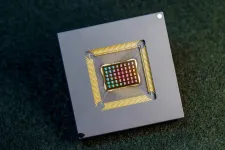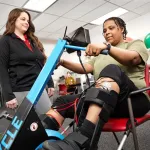(Press-News.org) Neuromorphic computing—a field that applies principles of neuroscience to computing systems to mimic the brain’s function and structure—needs to scale up if it is to effectively compete with current computing methods. In a review published Jan. 22 in the journal Nature, 23 researchers, including two from the University of California San Diego, present a detailed roadmap of what needs to happen to reach that goal. The article offers a new and practical perspective toward approaching the cognitive capacity of the human brain with comparable form factor and power consumption.
“We do not anticipate that there will be a one-size-fits-all solution for neuromorphic systems at scale but rather a range of neuromorphic hardware solutions with different characteristics based on application needs,” the authors write.
Applications for neuromorphic computing include scientific computing, artificial intelligence, augmented and virtual reality, wearables, smart farming, smart cities and more. Neuromorphic chips have the potential to outpace traditional computers in energy and space efficiency, as well as performance. This could present substantial advantages across various domains, including AI, health care and robotics. As the electricity consumption of AI is projected to double by 2026, neuromorphic computing emerges as a promising solution.
“Neuromorphic computing is particularly relevant today, when we are witnessing the untenable scaling of power- and resource-hungry AI systems,” said Gert Cauwenberghs, a Distinguished Professor in the UC San Diego Shu Chien-Gene Lay Department of Bioengineering and one of the paper’s coauthors.
Neuromorphic computing is at a pivotal moment, said Dhireesha Kudithipudi, the Robert F. McDermott Endowed Chair at the University of Texas San Antonio and the paper’s corresponding author. “We are now at a point where there is a tremendous opportunity to build new architectures and open frameworks that can be deployed in commercial applications,” she said. “I strongly believe that fostering tight collaboration between industry and academia is the key to shaping the future of this field. This collaboration is reflected in our team of co-authors.”
Last year, Cauwenberghs and Kudithipudi secured a $4 million grant from the National Science Foundation to launch THOR: The Neuromorphic Commons, a first-of-its-kind research network providing access to open neuromorphic computing hardware and tools in support of interdisciplinary and collaborative research.
In 2022, a neuromorphic chip designed by a team led by Cauwenberghs showed that these chips could be highly dynamic and versatile, without compromising accuracy and efficiency. The NeuRRAM chip runs computations directly in memory and can run a wide variety of AI applications—all at a fraction of the energy consumed by computing platforms for general-purpose AI computing. “Our Nature review article offers a perspective on further extensions of neuromorphic AI systems in silicon and emerging chip technologies to approach both the massive scale and the extreme efficiency of self-learning capacity in the mammalian brain,” said Cauwenberghs.
To achieve scale in neuromorphic computing, the authors propose several key features that must be optimized, including sparsity, a defining feature of the human brain. The brain develops by forming numerous neural connections (densification) before selectively pruning most of them. This strategy optimizes spatial efficiency while retaining information at high fidelity. If successfully emulated, this feature could enable neuromorphic systems that are significantly more energy-efficient and compact.
“The expandable scalability and superior efficiency derive from massive parallelism and hierarchical structure in neural representation, combining dense local synaptic connectivity within neurosynaptic cores modeled after the brain's gray matter with sparse global connectivity in neural communication across cores modeling the brain's white matter, facilitated through high-bandwidth reconfigurable interconnects on-chip and hierarchically structured interconnects across chips,” said Cauwenberghs.
“This publication shows tremendous potential toward the use of neuromorphic computing at scale for real-life applications. At the San Diego Supercomputer Center, we bring new computing architectures to the national user community, and this collaborative work paves the path for bringing a neuromorphic resource for the national user community,” said Amitava Majumdar, director of the division of Data-Enabled Scientific Computing at SDSC here on the UC San Diego campus, and one of the paper’s coauthors.
In addition, the authors also call for stronger collaborations within academia, and between academia and industry, as well as for the development of a wider array of user-friendly programming languages to lower the barrier of entry into the field. They believe this would foster increased collaboration, particularly across disciplines and industries.
Neuromorphic Computing at Scale
Dhireesha Kudithipudi and Tej Pandit, University of Texas, San Antonio
Catherine Schuman, University of Tennessee, Knoxville
Craig M. Vineyard, James B. Aimone and Suma George Cardwell, Sandia National Laboratories
Cory Merkel, Rochester Institute of Technology
Rajkumar Kubendran, University of Pittsburgh
Garrick Orchard and Ryad Benosman, Intel Labs
Christian Mayr, Technische Universität Dresden
Joe Hays, U.S. Naval Research Laboratory,
Cliff Young, Google DeepMind
Chiara Bartolozzi, Italian Institute of Technology
Amitava Majumdar and Gert Cauwenberghs, University of California San Diego
Melika Payvand, Institute of Neuroinformatics, University of Zürich and ETH Zürich
Sonia Buckley, National Institute of Standards and Technology
Shruti Kulkarni, Oak Ridge National Laboratory
Hector A. Gonzalez, SpiNNcloud Systems GmbH, Dresden, Germany
Chetan Singh Thakur, Indian Institute of Science, Bengaluru
Anand Subramoney, Royal Holloway, University of London, Egham
Steve Furber, The University of Manchester
END
Scaling up neuromorphic computing for more efficient and effective AI everywhere and anytime
2025-01-24
ELSE PRESS RELEASES FROM THIS DATE:
Make it worth Weyl: engineering the first semimetallic Weyl quantum crystal
2025-01-24
An international team of researchers led by the Strong Correlation Quantum Transport Laboratory of the RIKEN Center for Emergent Matter Science (CEMS) has demonstrated, in a world’s first, an ideal Weyl semimetal, marking a breakthrough in a decade-old problem of quantum materials.
Weyl fermions arise as collective quantum excitations of electrons in crystals. They are predicted to show exotic electromagnetic properties, attracting intense worldwide interest. However, despite the careful study of thousands of crystals, most ...
Exercise improves brain function, possibly reducing dementia risk
2025-01-24
A study led by scientists at Rutgers University-New Brunswick has shown that specialized cells involved in how the body responds to insulin are activated in the brain after exercise, suggesting that physical activity may directly improve brain function.
A study, published in Aging Cell, a journal focused on the biology of aging, indicates that therapies targeting this insulin action may be developed to offset or even prevent dementia progression.
“We believe this work is important because it suggests exercise may work to improve cognition and memory by improving the abilities of insulin to act on the brain,” ...
Diamonds are forever—But not in nanodevices
2025-01-24
Ultrawide-bandgap semiconductors—such as diamond—are promising for next-generation electronics due to a larger energy gap between the valence and conduction bands, allowing them to handle higher voltages, operate at higher frequencies, and provide greater efficiency compared to traditional materials like silicon. However, their unique properties make it challenging to probe and understand how charge and heat move on nanometer-to-micron scales. Visible light has a very limited ability to probe nanoscale properties, and moreover, it is not absorbed ...
School-based program for newcomer students boosts mental health, research shows
2025-01-24
The first randomized control trial of the school-based intervention called Supporting Transition Resilience of Newcomer Groups (STRONG) shows significant reductions in depression, anxiety and behavior problems among refugee and immigrant students. The study, funded by the National Institute of Mental Health, was co-led by Ann & Robert H. Lurie Children’s Hospital of Chicago and Loyola University, in partnership with the Chicago Public Schools (CPS). Results were published in the American Journal of Community Psychology. Key findings are summarized ...
Adding bridges to stabilize quantum networks
2025-01-24
While entangled photons hold incredible promise for quantum computing and communications, they have a major inherent disadvantage. After one use, they simply disappear.
In a new study, Northwestern University physicists propose a new strategy to maintain communications in a constantly changing, unpredictable quantum network. By rebuilding these disappearing connections, the researchers found the network eventually settles into a stable — albeit different — state.
The key resides in adding a sufficient number of connections to ensure the ...
Major uncertainties remain about impact of treatment for gender related distress
2025-01-24
Major uncertainties remain about the impact of puberty blockers and gender affirming hormone therapy on children and young people with gender related distress (gender dysphoria), making it impossible to determine conclusively whether they help or harm, find two pooled data analyses of the available evidence, published online in the Archives of Disease in Childhood.
The findings echo those of the Hilary Cass review of gender identity services in the NHS, published last April. This concluded that the evidence for the use of puberty blockers and masculinising and feminising hormones for gender related distress—psychological distress caused by a mismatch between birth sex and gender ...
Likely 50-fold rise in prevalence of gender related distress from 2011-21 in England
2025-01-24
The prevalence of psychological distress caused by a mismatch between birth sex and gender identity, formally known as gender dysphoria, likely rose 50-fold nationwide between 2011 and 2021, suggests an analysis of primary care data in England and published online in Archives of Disease in Childhood.
This means the condition is still uncommon, with fewer than 1 in 200 17-18 year olds affected, but levels of concurrent anxiety, depression, and self harm are high. And access to timely care is a live issue for young people and their families, a second feedback study shows.
Most previously ...
US college graduates live an average of 11 years longer than those who never finish high school
2025-01-24
Over the course of two decades, the lifespan of college graduates increased by 2.5 years to 84.2 years. If they were a country, their life expectancy would have ranked fourth globally.
By contrast, the lifespan of those who didn’t earn a high school diploma remained at 73.5 years. If they were a country, their life expectancy would have ranked 137th globally.
SEATTLE, Wash., Jan. 23, 2025 – Across more than 3,000 US counties, vast geographic differences with a widening gap were registered between the least and most educated, with a longer lifespan for those with a higher level of education. That’s ...
Scientists predict what will be top of the crops in UK by 2080 due to climate change
2025-01-24
While climate change is likely to present significant challenges to agriculture in coming decades, it could also mean that crops such as chickpeas, soyabeans and oranges are widely grown across the UK, and home-produced hummus, tofu and marmalade are a common sight on our supermarket shelves by 2080.
A new study led by the UK Centre for Ecology & Hydrology (UKCEH) in collaboration with the University of East Anglia (UEA) predicts that future warmer temperatures in this country would be suitable for a variety ...
Study: Physical function of patients at discharge linked to hospital readmission rates
2025-01-23
Researchers from The Ohio State University Wexner Medical Center and College of Medicine’s School of Health and Rehabilitation Sciences (HRS) recently published a study that found a link between impairments in physical function and hospital readmission risk among adults 50 years of age and older.
According to the Agency for Healthcare Research and Quality, 17% of Medicare beneficiaries in the United States returned to the hospital within 30 days of discharge between 2016 and 2020, posing burdens on healthcare systems and patients, alike.
“Physical function is a crucial indicator of underlying ...



